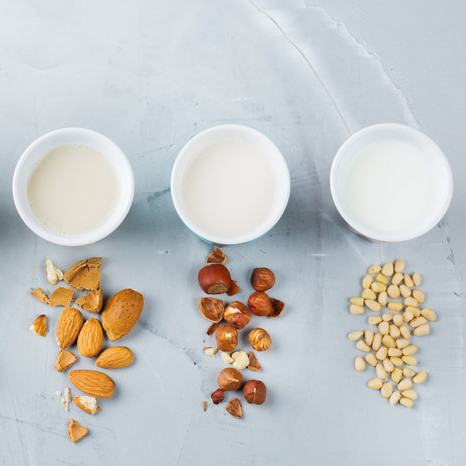
Dairy Alternatives
Also known as dairy substitutes
What are dairy alternatives?
Dairy alternatives are ingredients used to replace dairy components in food products. Demand for such ingredients has been driven by consumers’ concern about dairy allergies, lactose intolerance, hypercholesterolemia, high caloric foods and adoption of special diets such as vegans.
Classes of dairy alternatives include:
- Nut based
- Legume based
- Cereal based
- Pseudo cereal based
- Seed based
Origin
Dairy alternatives have been around as early as 1200 AD when the term milk was associated with plant liquid extracts. Coconut milk is probably the oldest plant-based milk which originated in India and Southeast Asia. Other dairy alternatives include milk of soy, almond and others.2
Function
Here is a brief summary of the most commonly used dairy alternatives in bakery products. The choice of a given ingredient depends on the dairy component to be replaced: 1,2,3
| Dairy Product | Common Milk Substitutes | Function |
|---|---|---|
| Eggs | Moisture replacement: Plant-based milks, non-dairy yogurt
Egg replacers for structure building: mostly starches from potato, tapioca, gums, soy flour, flaxseed meal. Egg replacers for leavening: chemical leaveners. |
|
| Butter | Margarine, non dairy shortening, complex polysaccharides. |
|
| Milk | Milk from nuts, seeds, cereals and legumes as well as apple sauce. |
|
| Yogurt | Non dairy yogurts, coconut milk creamer, non-dairy milk with applesauce |
|
| Buttermilk | Plant based milks mixed with an acid such as lemon juice, vinegar, apple cider vinegar, etc |
|
Nutrition
Dairy alternatives offer many health benefits such as added calcium and B- vitamins, no/low cholesterol or lactose. Some dairy alternatives provide a high protein content (soy milk) or soluble fibers (oat milk). 2
Commercial production
Plant- based milk alternatives are typically produced through the following process: 2
Wet processing
- Soaking: cereals, legumes, nuts or seeds are placed in a kettle with water and salt for up to 12 hours.
- Rinsing and draining
- Grinding: soaked cereals, legumes, nuts or seeds are ground into a smooth puree.
- Formulation: water, flavors, vitamins and minerals are added.
- Thermal processing to ensure food safety.
Some further processing may be added depending on the plant-based alternative.
Dry processing
- Drying: cereals, legumes, nuts or seeds are dried.
- Grinding: dried cereals, legumes, nuts or seeds are ground into a fine powder.
The fine powders are later used as a base for baking, beverages or other formulations.
Application
Dairy alternatives are used to replace dairy products in a variety of baked goods, such as: cakes, cookies, brownies, bread, among others. 2,3
When working with dairy alternatives some considerations must be taken into account: 2,3
| Dairy Alternative | Baked Good | Substitution (general guidance) |
|---|---|---|
| Water or plan-based milks | Bread, pastries, biscuits and cookies | 1 cup substitutes 1 cup of milk. |
| Soy Flour | Sugar cookies, cake, muffins and pancake | Replace 1 egg with 1 tablespoon of soy flour and 1 tablespoon of water |
| Flaxseed Powder | Cake, biscuits and custard | Replace 1 egg with 25 g of flaxseed and 25 mL of water |
| Tofu | Cheesecake | Replace with 50% firm tofu and 50% soft tofu. |
| Margarine | Cake, biscuits, and cookies | Replacing butter in 1:1 ratio provides a mild flavor |
| Plant-based Milks | Cakes with buttermilk | Add 2 tablespoons of lemon juice to 1 cup of plant-based milk |
| Applesauce or fruit purées | Brownies, cookies muffins | Replace 1 egg with 3 tablespoons of applesauce |
Regulations
There is an ongoing debate regarding the labeling of plant-based dairy alternatives.
In the US, the FDA defines milk as the secretion of a mammal, and thus plant-based alternatives do not fall under this labeling category. No clear legislation has been put forward for plant based labeling status.4
In the EU, the terms milk, egg, butter, yogurt, cream and buttermilk are reserved for animal derived products according to the EU Commission No 1308/2013.5
References
- Hui, Y. H., Corke,H., DeLeyn, I., Nip, W-K and Cross,N. Bakery products: science and technology. 1 st ed., John Wiley & Sons, 2006.
- McHugh, T. “How plant-based milks are processed.” Food Technology 72 (2018): 63-64.
- Figoni, P. How Baking Works: Exploring The Fundamentals Of Baking Science. 2nd ed., John Wiley & Sons, Inc., 2008.
- US Food and Drug Administration. “Statement from FDA Commissioner Scott Gottlieb, M.D., on modernizing standards of identity and the use of dairy names for plant-based substitutes”. 27 September 2018.
- European Commission (Ec). Commission Regulation (Eu) No 1308/2013 Of The European Parliament And Of The Council Of 17 December 2013 Establishing A Common Organisation Of The Markets In Agricultural Products And Repealing Council Regulations (Eec) No 922/72, (Eec) No 234/79, (Ec) No 1037/2001 And (Ec) No 1234/2007 . Official Journal Of European Communities, 12 December 2013.

